Robert T. Gunther, The astrolabe. An extract from Astrolabes of the World (1932) pp.51-60.
CHALDAEAN ORIGINS
THE recent discoveries of bygone civilizations at Ur and at other Mesopotamian sites might well give ground for hope that further evidence as to the scientific attainments of the earliest Wise Men of the East might be forthcoming. Unfortunately nothing remarkable in the way of astronomical instruments has as yet been found, but they must surely have filled some
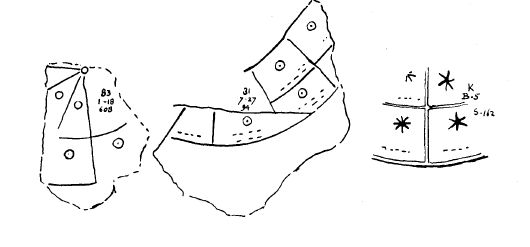
Fig. 52. Rough sketch of astronomical fragments from Nineveh.
place in a Babylonian astronomer's equipment. A most convincing argument has recently been developed by my friend Dr. Fotheringham,1 which shows that at least two Chaldaeans, Naburianos (c. 500 B.C.) and Cidenas or Kidinnu (383 B.C.) are entitled to places among the greatest of astronomers in view of the accuracy of their observations of lunar eclipses, and of their systems of computing the phases and motions of the Sun and Moon from observations that extended over centuries. There is testimony that some of the constants which were formerly regarded as discoveries of Hipparchus |52 were derived by him from Cidenas, and Dr. Fotheringham concludes that the Greeks took and used Chaldaean science, but gave nothing in return. The historic eclipse which served as the omen of the destruction of Ur, has been identified by Herr Schoch with the eclipse of March 3, 2283 B.C. Any evidence of instrumental methods is therefore of the highest interest, and, as a matter of fact, some engraved fragments were found by Layard in the Library at Kouyunyik which seem to be astronomical diagrams. It is from such a source that the ancestor of the astrolabe may come.
It is therefore to be hoped that further excavation may yield less fragmentary examples, by means of which the use of these enigmatical star-plates (?) may be determined. In the meantime we may restate the widely-spread belief that the Sumerian mathematics and calendar, the division of the equator into 360 degrees, the division of the Zodiac into the 12 Signs, the constant use of the convenient number 60 at an early date, all imply the use of measuring instruments of no primitive order. |53
GREEK ASTROLABES
Humanity cannot afford to lose out of its inheritance any part of the best work which has been done for it in the past. All that is most beautiful and most instructive in Greek achievement is our permanent possession; one which can be enjoyed without detriment to those other studies which modern life demands; one which no lapse of time can make obsolete, and which no multiplication of modern interests can make superfluous. --- R. C. Jebb
IT is one of the tragedies of classical archaeology that no example of an ancient scientific instrument has yet been revealed at any of the innumerable sites where excavations have been carefully conducted. It is possible in the past that collectors, who have specialized in drinking-vessels, coins, sculpture, gems, and articles of gold and silver have been responsible for the neglect and destruction of other objects of unknown use, but it is also probable that the use of scientific instruments was confined to the very few, even as the use of large telescopes is confined to few men of science at the present time.
But if there be no tangible object used by the Greeks now remaining which we may unhesitatingly term an astrolabe, the name of the whole instrument is Greek. And though several of the conventional names of its parts are derived from Arabic, the designation ἀστρολάβον is in itself lasting evidence to a use among a Greek-speaking people.
It is customary to refer to the Planispheric Astrolabe, the principal theme of this work, as the invention of the great Alexandrian savant, HIPPARCHUS of Bithynia, born c. 180, died c. 125 B.C. It is said that he was the first man to apply a theory of stereographic projection to the drawing of the celestial sphere upon the plane of the equator. The planispheric astrolabe is impossible without this projection, so that if Hipparchus had really been the first exponent of this projection, there could have been no astrolabe before his day. His knowledge, however, might have remained infertile, had not his successor, PTOLEMY, codified in one great book the principal discoveries of his predecessors. In this, 'the greatest' or Almagest, he used and elaborated their researches; and there is probably no case in the history of the world in which a book and an instrument have interacted, the one upon the other, more than Ptolemy's Almagest and the Astrolabe.
But there are at least two trains of evidence which point to a far earlier |54 date for the invention. The Arabs themselves were aware of a tradition that the Astrolabe was invented before Ptolemy, witness a passage in Ibn Abi Yakub an-Nadim (c. a.d. 987),2 and the seventh-century writer Severus Sabokt, whose treatise we are now publishing in English for the first time, is careful to distinguish between Ptolemy and 'the philosopher who invented the astrolabe' whom he mentions three times, or 'this philosopher' whom he mentions five times. That 'this philosopher' was older than Ptolemy seems to be established by the fact that he is quoted as having taken the imperfect and very ancient value of 24° for the obliquity of the ecliptic, a value that dates from the days of Eudemus, a contemporary of Aristotle, whilst Ptolemy adopted 23° 51'.
This pregnant suggestion, made by Nau, affords a clue to two passages in Vitruvius, one of which gives the name of the inventor of the planispheric astrolabe----which, be it remembered, was specially used for the determination of the day and night hours by means of the rotation of an arachne or 'spider', afterwards called rete by the Latins. Vitruvius (Arch. ix. 9), enumerating the inventors of various timepieces, writes Arachnen Eudoxus astrologus, nonnulli dicunt Apollonium, 'Eudoxus the astronomer, or according to some Apollonius (invented) the arachne.' The dates of these savants were: EUDOXUS of Cnidus 409-356 B.C.; APOLLONIUS of Perga third century B.C.; VITRUVIUS first century B.C. ; PTOLEMY first century A.D.
Eudoxus was a pupil of Plato, and about 320 B.C. introduced astronomical lore from Egypt into Greece. He instructed his fellow-countrymen as to the length of the year, and he is credited with the invention of the a0ra&xnh, which in all probability was the map of the constellations which can be turned upon the face of an astrolabe. And it should be remembered in a survey of origins of a material nature, that it was in his time that a great reform was made by the substitution of Egyptian papyrus for Greek sand, as a surface upon which astronomical notes and calculations could be made and preserved.
Vitruvius, in a later passage describes 'anaphoric' timepieces, which are in the main, only 'mechanized' astrolabes. Such timepieces were made of two parts; one was fixed, was limited to a certain latitude and bore the hours (this is the fixed plate of the astrolabe); the other represented the heavens, more particularly the sun, represented by a nail, and the signs of the zodiac (this is the arachne of the astrolabe). The second part was driven |55 round with a uniform movement, thus reproducing the diurnal rotation and always showing us the stars in their actual disposition. There is no need to measure an altitude of the sun and to derive the hour of the day from it: it is sufficient to look at the instrument to see in what hour the sun is. These anaphoric timepieces, in which the essential element is a planispheric astrolabe, give good ground for supposing that the astrolabe was a still earlier invention, and consequently may have been contrived (as Vitruvius has said) by Eudoxus, or perhaps by Apollonius of Perga.
1. THE ASTROLABE OF ANTICYTHERA c. a.d. 250.
One, and only one, piece of apparatus that may have been an Astrolabe of Greek origin has been discovered. It was dredged up from the bed of the sea off Anticythera, and is most remarkable for a marvellous system of mechanical motion which it contains, and which shows a great advance upon an ordinary simple astrolabe. It has been described by Professor Pericles Rediadis, and is conserved in the Athens National Museum. In an encrusted corroded mass of copper and sand are two plates inscribed in Greek characters and several cog-wheels; the whole having been originally contained in a wooden case. The lettering on the plates has mostly perished, but a part of one of the words reads ...]γνωμό[----, which has been restored as μοιρογνωμόνιον: it is considered to indicate the astronomical use of the instrument, and has been thought to refer to a part of an astrolabe. On the other hand the learned author argues that the presence of cog-wheels makes any such attribution uncertain if not impossible. On this matter we are now in the position of being able to produce new evidence, namely that there is in the Lewis Evans Collection an astrolabe with a geared calendar movement of cog-wheels within it, see p. 118, which proves that such an association of mechanism with an astrolabe or a sundial is by no means impossible.
The largest of the four fragments that have been conserved is composed of two rectangular copper plates measuring about 0.135m x 0.160m. and about two millimetres in thickness. They are rivetted so as to appear as a single plate, but the ends of connecting rivets are quite visible. Upon one side is a large copper cog-wheel of 0.131m. diameter, with four unequally broad spokes, and about 216 teeth. By the wheel is a piece of metal, by means of which the wheel would have been kept steady at the same level; |56 and there seem to have been several other such pieces in the instrument. On the same side at ψ is something that looks like the nave of a second, but smaller cog-wheel now lost, which may have geared into the first, or perhaps, may have been the axis-head of a small wheel that can be recognized on the other side of the machine. On the left-hand side is a projection, which seen from the side is of the form shown in Figure 54. Near by is a peg which appears
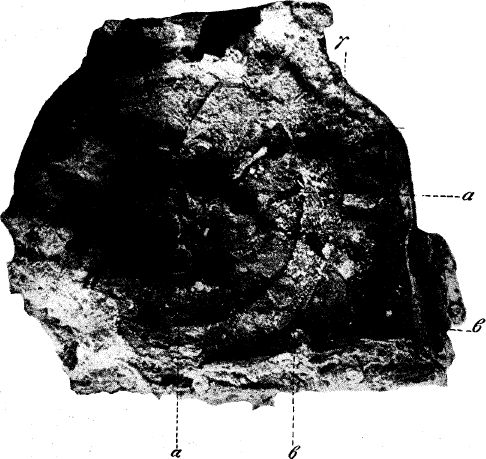
Fig. 53. The Astrolabe of Anticythera
After Rediadis
to have supported a cylindrical axle of 3 cm. interior diameter, the centre of which was grooved for the insertion of a key (still extant) of the shape shown in Figure 55; by means of this key the axle was turned, its motion being communicated to the large wheel. Finally, in connexion with this arrangement, the wheel is provided with a perpendicular double peg of about 3 cm. high, which has been explained as a sight for taking bearings.
On the other side of the fragment are further traces of complicated mechanism. First, there are two concentric rings of cogs, the larger of which is about 0.104m. in diameter (figure 56), and bears two small rectangular head-pieces, ζ. Over the rings is a small cog-wheel of 0.028 m. diameter, |57 held in place by means of a bar which was fastened by the rivet θ. This small wheel h has a quadrangular nick ι in the margin and is geared to another small wheel, which is centred on the axis ε of the large ring with the cogged edges. At γ one can make out a small wheel, the axle-head of which apparently, as was stated above, appears on the other side at ψ. At θ was noticed the raised sign, PI, which most likely belonged to the inner surface of the
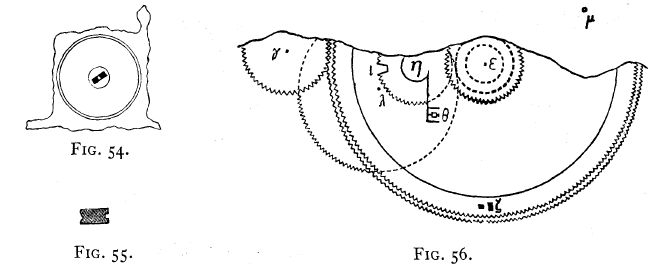
two plates of the piece. Near the middle part is the vestige of an inscription, running to the right, but according to Svoronos only a few incomplete words, could be deciphered. On examining the fragment from the side, one can see that below the large ring, and centred on its axis e, are two small wheels of about 0.025 and 0.020 m. diameter, of which the larger one gears with another turning about centre point λ; the smaller geared with a wheel, of which the axle μ is only just visible.
On one side of the second fragment is an inscription which has been deciphered with difficulty by J. Svoronos, as directions for use, as follows:
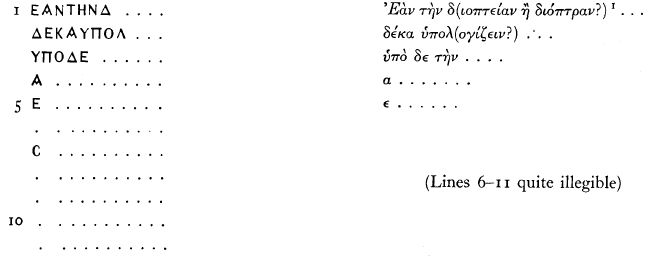
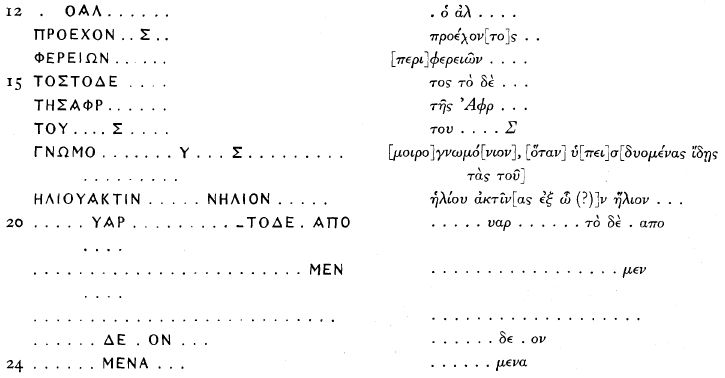
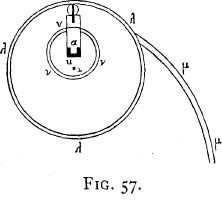 At the back of this fragment are about seven concentric, deeply-cut circles, about 0.006 m. apart, which seem to have served as guide-lines for a
At the back of this fragment are about seven concentric, deeply-cut circles, about 0.006 m. apart, which seem to have served as guide-lines for a
pin fastened to one end of a double-shanked pointer. This pointer moved about the axis b, situated eccentrically to axis a of the concentric circles, and was fitted with cog-wheels of 0.023 m. diameter. Below axis a is perceptible, as seen from the side, the trace of something like another small cogwheel.
The third fragment shows an illegible inscription and an embossed ring XX around τ as centre, which cuts a similarly embossed and curved edge mm, as shown in Figure 57. At the centre of the ring is inscribed the letter τ. From the point α, a little to one side of the centre, there projects something like a movable writing-stylus. Around the end α of this pin as centre, was a small ring, νν, of which traces, though faint, can just be recognized. Lastly, there is a small detached cog-wheel eccentric to the embossed ring, XX, of 0.022 m. diameter.
Though without personal inspection we can hardly accept this antiquity from Anticythera as a true astrolabe, it is certainly a fragment of a scientific instrument which well deserves the fullest consideration. |59
GREEK TREATISES ON THE ASTROLABE
It is when we come to Greek writers that we get on to surer ground. There can be no doubt but that Ptolemy was followed by many disciples, any one of whom might have left writings, but the only names that have been transmitted to us are those of THEON of Alexandria, who in the fourth century wrote a commentary on the work of his master, and SYNESIUS (died c. 430), an accomplished citizen of Cyrene, who himself designed a silver astrolabe as a present for his friend Paeonius, accompanying it, as Professor Jenkins did in 1928, with a treatise upon its use composed by himself. Synesius claimed to have invented the planispheric astrolabe, having perfected in his instrument 'a hint thrown out by Hipparchus, but disregarded by the famous Ptolemy and his great successors'.3 Unhappily neither the instrument nor the treatise of Synesius has survived.
Better fortune attends the work of Proclus and his school. PROCLUS DIADOCHUS (d. 485) discoursed upon the Almagest at Athens, and there taught Ammonius, who in turn passed on his knowledge to JOHN PHILOPON of Alexandria, and he, about the time of the Great Fire at the Library (a.d. 642), wrote a small book on the Astrolabe. This ancient Greek work, produced from a true Greek source shortly before the beginning of the Mohammedan era, was a thousand years old when our Royal Society was founded. It has never been printed by an English press; few classical scholars have ever opened its pages, and the greater number of these have been deterred from reading it through lack of the education necessary to comprehend its meaning. We are now able to print a literal rendering into English as an introduction to a Byzantine Greek instrument that may be regarded as the last surviving example of an Astrolabe made by a true heir to the craft of an original Greek designer. The difficulty of the language is apparent from the translation which follows.
I cannot thank too warmly my old friend and colleague, Herbert Greene, late Fellow of Magdalen, for having postponed his work for the new edition of Liddell and Scott's Lexicon to make this literal translation from Hase's edition of Philopon's περὶ τῆς τοῦ ἀστρολάβου χρήσεως καὶ κατασκευῆς.
It is most interesting to compare Philopon's venerable work with another and almost contemporary treatise, for only a few years later, and in the same |60 century, a bishop of Kennesrin in Syria, SEVERUS SABOKHT of Nisibis, also produced a full account of the Astrolabe for the use of his countrymen. There can be no doubt that he too obtained his knowledge from Greek sources, so that, although he wrote in Syriac, an English rendering of which is printed below, his treatise must be considered as having the value of a direct translation from the work of a contemporary Greek writer of the period, who had been brought up on the lore of his predecessors. Bishop Sabokt was well versed in mathematical and astronomical, as well as in ecclesiastical, knowledge; in this respect he may be compared with several of our own bishops who were trained at Merton College in the fourteenth century. He could read Greek and doubtless studied Ptolemy in the original language. So that when he suggests that Ptolemy's astronomical tables are based on observations made with an astrolabe, it at once raises the question whether Ptolemy's astrolabe may not rather have been identical with the planispheric astrolabe described by Sabokt, than of the nature of an Armillary Sphere, the instrument which Raphael has put into the hand of his picture of Ptolemy in the well-known sketch in the Accademia in Venice.
However that may be, the treatise of Sabokt is fuller than that of Philopon, is brightly written, and is evidently the work of a man quite familiar with his subject.
Mr. Dalton considers that in after centuries there were old Greek scientific books still available to students in Constantinople, and from this he ingeniously argues that such books were likely to have been accessible in libraries for centuries before. Thus in c. a.d. 1300 Theodore Metochites was able to study Ptolemy, Apollonius of Perga, Nicomachus, and Euclid. But of greater present import is the fact that a late Greek instrument is still extant.
[Footnotes moved to the end and renumbered]
1. 1 J. K. Fotheringham, 'The Indebtedness of Greek to Chaldean Astronomy'. The Observatory, 1928.
2. 1 Gunther, Early Science in Oxford, ii, p. 189.
3. 1 W. S. Crawford, Synesius the Hellene, 1901, p. 461, quoted by O. Dalton.
This text was transcribed by Roger Pearse, Ipswich, UK, 2005. All material on this page is in the public domain - copy freely.
Greek text is rendered using unicode.
| Early Church Fathers - Additional Texts |